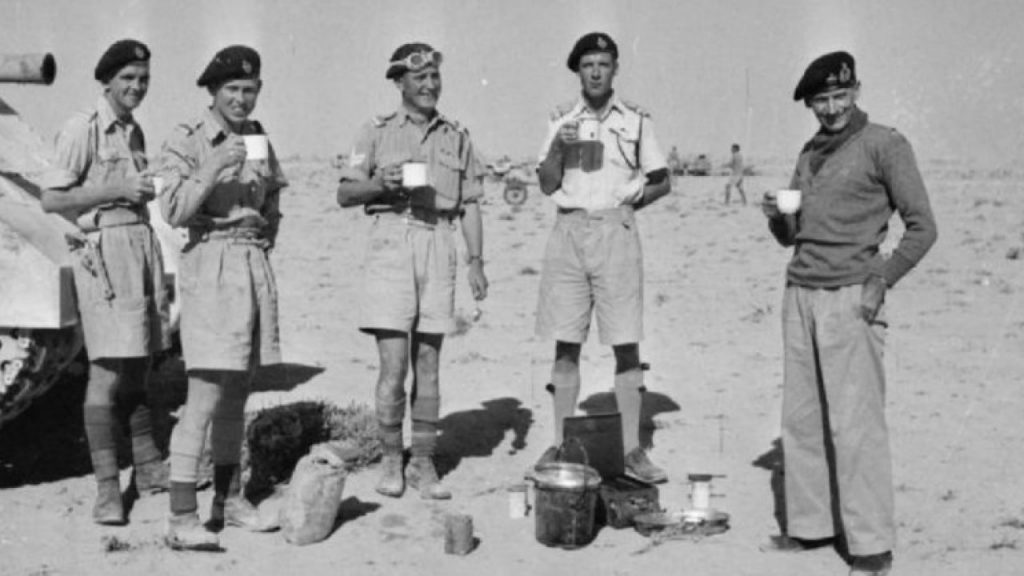The Tommy And His Tea.


One must never underestimate the importance of tea to the British soldier. It’s true now; it was even more significant in WWII.
In barracks and camps, large urns of tea were housed in the cookhouses and dining halls. When soldiers were off duty, they could buy a cup at the NAAFI canteen found on every base (NAAFI was the Navy, Army, Air Force Institute). There were also mobile canteens which followed the men on training exercises; most of these were operated by the NAAFI, but others were from the YMCA, Salvation Army, and other civilian organizations.
Tea was absolutely vital to the soldiers’ morale. Naturally, it contains caffeine and can provide a boost of energy; but there are many who find it calming, as well. Tea is a part of British culture, even more so in the 1940’s than today. To the soldier, it was more than just a beverage; it was a reminder of home, family, and happier times.
While tea breaks were commonly permitted on exercise, this was an impossible luxury in combat operations. Nevertheless, the troops became adept at quickly brewing tea at every possible opportunity. Any time a halt was called, and if there were no bullets flying overhead, out would come the tea.
There is a sequence in the film “A Bridge Too Far” when Robert Redford accuses the Grenadier Guards of halting their advance in order to drink tea. I always thought that seemed a bit unfair, although that may have been how it appeared to the Americans. I prefer the scene in which General Urquhart is upset at the challenges he is facing, so his batman hands him a cup of tea. Urquhart complains, but drinks it anyway.
The Army issued portable petrol stoves in various sizes; the smallest had a single burner and was issued at the section level (8 men). However, the stoves were kept in the motor transport well behind the advancing infantry and were not available during a short halt. Even if the “collective stove” was available, the early ones were unreliable and tended to clog with dirt and sand; this was a major issue in North Africa. The troops were determined to have their tea, and therefore became masters of improvisation.

Some vehicle crews became adept at using a hot engine to boil water for tea. In North Africa, it was common to use a “Benghazi burner” or “Benghazi cooker”, which was simply a cut-down petrol or water tin, filled about halfway with sand. The sand was then soaked in petrol and set alight, and could boil water in a very short amount of time.
Small folding stoves which used solid fuel tablets were developed; it was intended that every man should receive one, but priority of issue seems to have been for troops destined for Northern Europe.
Small batches of tea could be brewed in the standard mess tin. To heat it faster, the smaller side was used to make the tea, with the larger side on top as a lid. For larger batches, an improvised kettle was often made from a ration tin. Often, a rifle section or vehicle crew would designate one man to be in charge of making tea; sometimes, it was the most junior man, but often it was someone with a special knack for unpacking the supplies and getting the water on the boil in a hurry.

While the tea bag had been invented prior to WWII, it was not common until after the war; most tea was loose leaf. Sugar was also issued, along with either powdered milk or sweetened condensed milk. There was also an instant tea which consisted of dehydrated tea already mixed with sugar and powdered milk. Tins of this mixture were included in the composite ration crates (known as “compo”). These tins are popular with modern collectors; I have one in my collection. Small packets of instant tea were also included in the 24 hour ration pack.
A note on soldier’s slang: the act of building a fire or lighting a stove and making tea was known as “brewing up”. The tea break itself then became known as a “brew up”, and the equipment needed was the “brew up kit”. The folding solid-fuel stove was known as a “Tommy cooker”. However, with the British soldiers’ ironic sense of humor, when a vehicle caught fire, it was also said to brew up; the Sherman tank had a nasty tendency to brew up easily when shot, so it too was called a Tommy cooker. “Gurkha Tea” contained more condensed milk than tea.
Extracted from: Robertshaw, Andrew
Frontline Cookbook: Battlefield Recipes from the Second World War
The History Press, 2012 & Clayton, Anthony
Battlefield Rations: The Food Given to the British Soldier for Marching and Fighting 1900 – 2011
Helion & Company Ltd., 2013

